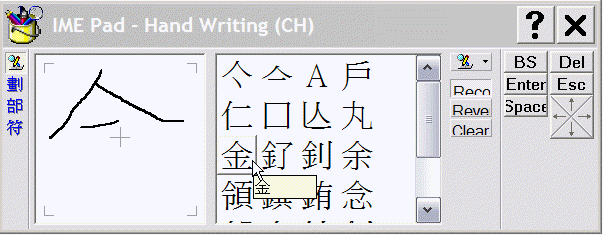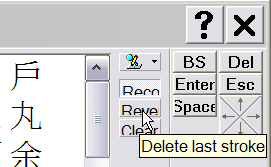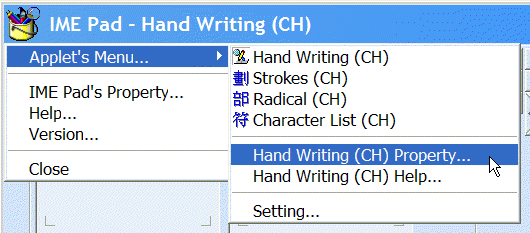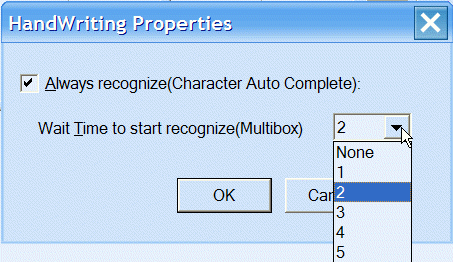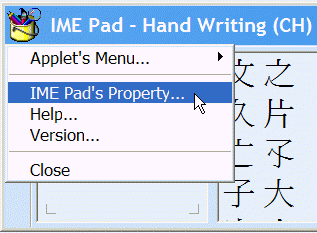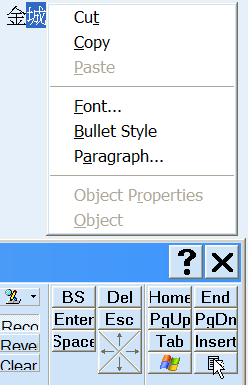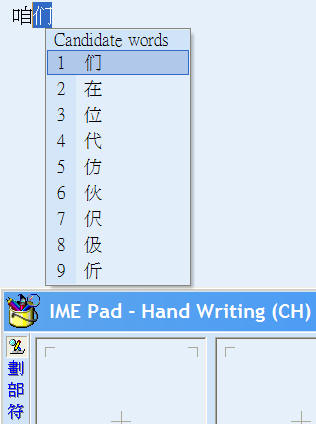| Home │ Part 1 │ Part 2 │ Part 3 │ Part 5 │ | ||
Installing and using handwriting recognition in Windows XP and Office XP/2003 Part 4
[6] Exploring handwriting recognition in more details (continued)
Note: this page contains text characters in Traditional Chinese: to display these correctly you may need to adjust your browser's encoding.
6.2. Chinese handwriting recognition6.2.1. Writing (IME) PadThis applies to both the English and Traditional Chinese versions of Windows XP; section 6.2.1.1 below refers to the scenario without Traditional Chinese Office XP or 2003 and section 6.2.1.2 with Traditional Chinese Office 2003. The illustrations are made using English Windows XP: apart from the graphic user interface there is no difference. As will be explained below, Writing Pad refers to that in Office XP/2003 and IME Pad the one in Microsoft New Phonetic (or ChangJie) IME 2002/2003: they are not synonymous.
6.2.1.1. Microsoft New ChangJie IME 2002/2003 and Microsoft New Phonetic IME 2002/2003This applies to English and Chinese Windows XP. To use the Chinese IME Pad in a document, do this:
change the language to Chinese (Taiwan) in the language bar, The pad is context sensitive and will appear only when you have a compatible programme like Word or WordPad open.
Fig. 1. Choosing the IME pad in the Tools menu of the language bar.
The Chinese IME pad offers a list of possible matching characters usually before you finish completing the character. The list updates itself as you put more strokes in for a closer match. The built-in Chinese and English versions of the IME Pads are identical. The following figures shows the build-in Chinese version in Traditional Chinese Windows XP (fig. 2).
Fig. 2. IME pad in Microsoft New Phonetic IME 2002a in Traditional Chinese Windows XP.
There are four basic means of inputting characters using the IME Pad: Handwriting, Strokes, Radical and Symbols. Their buttons are on the left Applet Bar which can be moved to the right (see below). The Hand Writing (CH) [手寫識別 (CH)] mode is the default (fig. 3).
Fig. 3. IME Pad: Hand Writing, Multibox mode.
In Strokes (CH) [筆劃查詢 (CH)] mode you choose the number of strokes of the whole character and choose the right character from the list (fig. 4).
Fig. 4. IME Pad: Strokes (CH) mode.
In Radical (CH) [部首查詢 (CH)] mode you pick the number of strokes and choose the radical with this number of strokes (fig. 5).
Fig. 5. IME Pad: Radical (CH) mode.
In Character List (CH) [符號查詢 (CH)] mode, there is a variety of different sets of symbols (fig. 6).
Fig. 6. IME Pad: Character List (CH) mode.
The IME Pad Hand Writing mode in turn has two basic modes: Character Auto Complete and Multibox. This shows the Character Auto Complete mode: you enter the strokes on the left box and a list of possible matches are presented on the right (fig. 7).
Fig. 7. Microsoft New ChangJie IME Pad in Windows XP (En) and Office XP (En.) with New ChangJie IME installed.
In Multibox mode, both boxes are available for character entry so you can enter the second character on the right after the first on the left (in this order); there is a slight delay for character recognition and entry into the document (depending on your computer speed) so this method could slightly speed up the process (fig. 8).
Fig. 8. IME Pad: Hand Writing, Multibox mode.
This illustrates Character Auto Complete in action in more detail. The button for Recognize drawing and display candidate is active (Microsoft regards characters as drawings here). When you hover the mouse pointer over a possible candidate the ChangJie code is shown in a small pop-up. Simply click the character to enter the whole character into the document without having to typing the rest (fig. 9). This code pop-up prompt also works in New Phonetic IME Pad.
Fig. 9. IME Pad: Hand Writing, Character Auto Complete mode.
You can delete the last stroke easily if entered incorrectly by clicking the middle button (fig. 10) or delete everything by clicking the Clear button.
Fig. 10. IME Pad: Hand Writing, Delete last stroke button.
You can configure Handwriting Property by clicking the icon in the top bar, Applet's menu, Handwriting (CH) Property (fig. 11).
Fig. 11. Applet's menu, Handwriting (CH) Property
The options are self-explanatory (fig. 12).
Fig. 12. Handwriting Properties
Extend the IME Pad by selecting IME Pad's Property (fig. 13).
Fig. 13. Select IME Pad's Property.
Tick the Extended Buttons option to have more on the pad (fig. 14). The Applet bar is on the left by default.
Fig. 14. IME Pad Property: Extended Buttons option.
The extra buttons are on the right (if you choose Right in the above box) and you can drag the border to extend the number of boxes (fig. 15).
Fig. 15. IME Pad with extended buttons on the right and three input boxes.
The extended buttons Home, End, PgUp and PgDn are for navigation on the page. The Start menu button opens the Windows Start menu; the Tab button moves the cursor to the next tab; the Insert button switches to inserting text directly on the document and the button in the bottom right corner opens a context menu in the document (fig. 16). You can also open this menu by right clicking directly in the document.
Fig. 16. IME Pad: Context menu
Immediately after a character has been recognised and displayed in the main text, you can change (edit) it by highlighting it and press the down arrow key. A list of Candidate words is displayed and lets you choose an alternative with the mouse or keyboard (fig. 17). This seems to work only with the last character you have just entered.
Fig. 17. Edit character using the Candidate words list.
Copyright © 2004-2005 by Kilian. All my articles including graphics are provided "as is" without warranties of any kind. I hereby disclaim all warranties with regard to the information provided. In no event shall I be liable for any damage of any kind whatsoever resulting from the information. The articles are provided in good faith and after some degree of verification but they may contain technical or typographical errors. Links to other web resources may be changed at any time and are beyond the control of the author. Articles may be added, removed, edited or improved at any time. No support is provided by the author. All the products mentioned are trademarks of their respective companies. This is not an official support page for any products mentioned. All the products mentioned are trademarks of their companies. Last updated 15 Nov 2005 |
||








